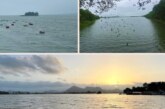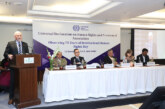The latest World Bank report has sounded alarm bells over the disastrous impact of climate change. It says by 2050, unchecked climate change causing higher temperatures and poor monsoon rainfall would diminish the living standards of the half of In dia’s population, particularly farmers in the central India.
dia’s population, particularly farmers in the central India.
Titled “South Asia’s Hotspots: The Impact of Temperature and Precipitation Changes on Living Standards,” the report gives detailed analysis of future scenario of India and notes that by 2050, Chhattisgarh and Madhya Pradesh will be the top two climate hotspot States in the country. They are likely to experience a decline of more than 9 per cent in their living standards, followed by Rajasthan, Uttar Pradesh, and Maharashtra.
Also, seven out of the top ten most-affected hotspot districts, including Chandrapur, Nagpur, Gondiya, Wardha, Yavatmal, belong to the Vidarbha region of Maharashtra, as per the report. This comes as grim news for the country’s farmers who are already facing severe agrarian and financial crisis.
The report notes that almost half of South Asia’s population, including India, now lives in vulnerable areas and will suffer from declining living standards that could be attributed to falling agricultural yields, lower labour productivity or related health impacts. Some of these areas are already less developed, suffer from poor connectivity and are water stressed.
Impact of climate change is already being felt. India’s average annual temperatures is expected to rise by 1°C to 2°C by 2050 even if preventive measures are taken along the lines of those recommended by the Paris climate change agreement of 2015. If no measures are taken, average temperatures in India are predicted to increase by 1.5°C to 3°C, as per the report.
The work scientifically identifies vulnerable States and districts as “hotspots” using spatial granular climate and household data analysis. The report defines hotspot as a location where changes in average temperature and precipitation will have a negative effect on living standards.
These hotspots are not only necessarily higher temperature zones than the surrounding areas, but also reflect the local population’s socio-economic capacity to cope with the climatic changes.
In India today, approximately 600 million people live in locations that could either become moderate or severe hotspots by 2050 under a business-as-usual scenario, the report says. States in the Central, northern and north-western parts of India emerge as most vulnerable to changes in average temperature and precipitation.
Muthukumara Mani, main author of the report and Lead Economist in the South Asia Region of the World Bank said “these weather changes will result in lower per capita consumption levels that could further increase poverty and inequality in one of the poorest regions of the world, South Asia.”
“Identifying hotspots will help policymakers in finding specific locations and household types where the resources are needed the most to address the rising risk to living standards.”
The report provides options to prioritise investments and strategies to build local resilience to climate change. To offset the negative economic impact in India, for example, the analysis suggests enhancing educational attainment, reducing water stress, and improving job opportunities in the nonagricultural sectors.
The analysis predicts that a 30 per cent improvement on these measures could halt the decline in living standards by almost 1 per cent from-2.8 per cent to-1.9 per cent.
According to experts the scale of tree destruction, poses a grave threat to tackling both climate change and the massive global decline in wildlife.
By | Archana Jyoti | New Delhi



